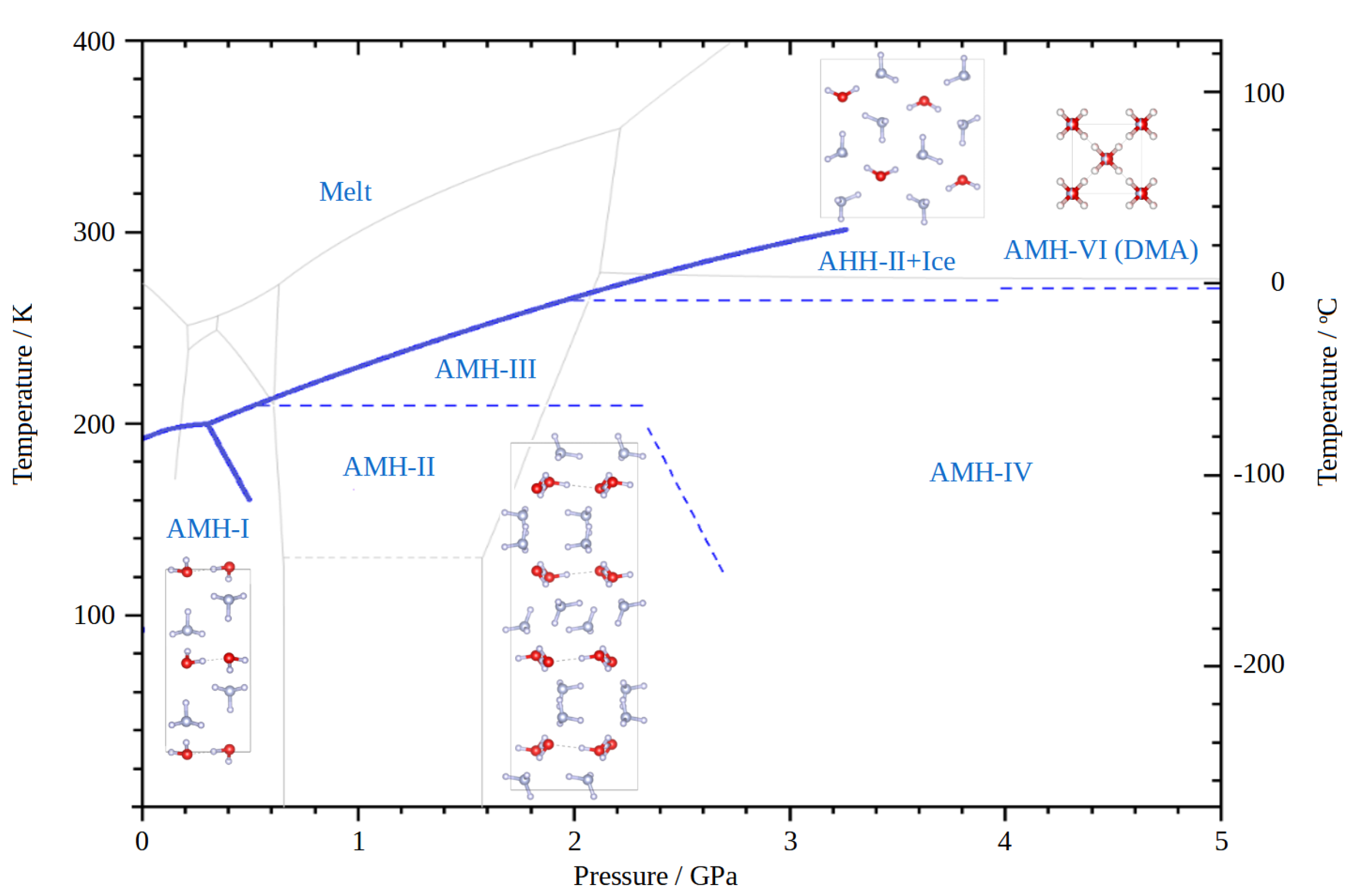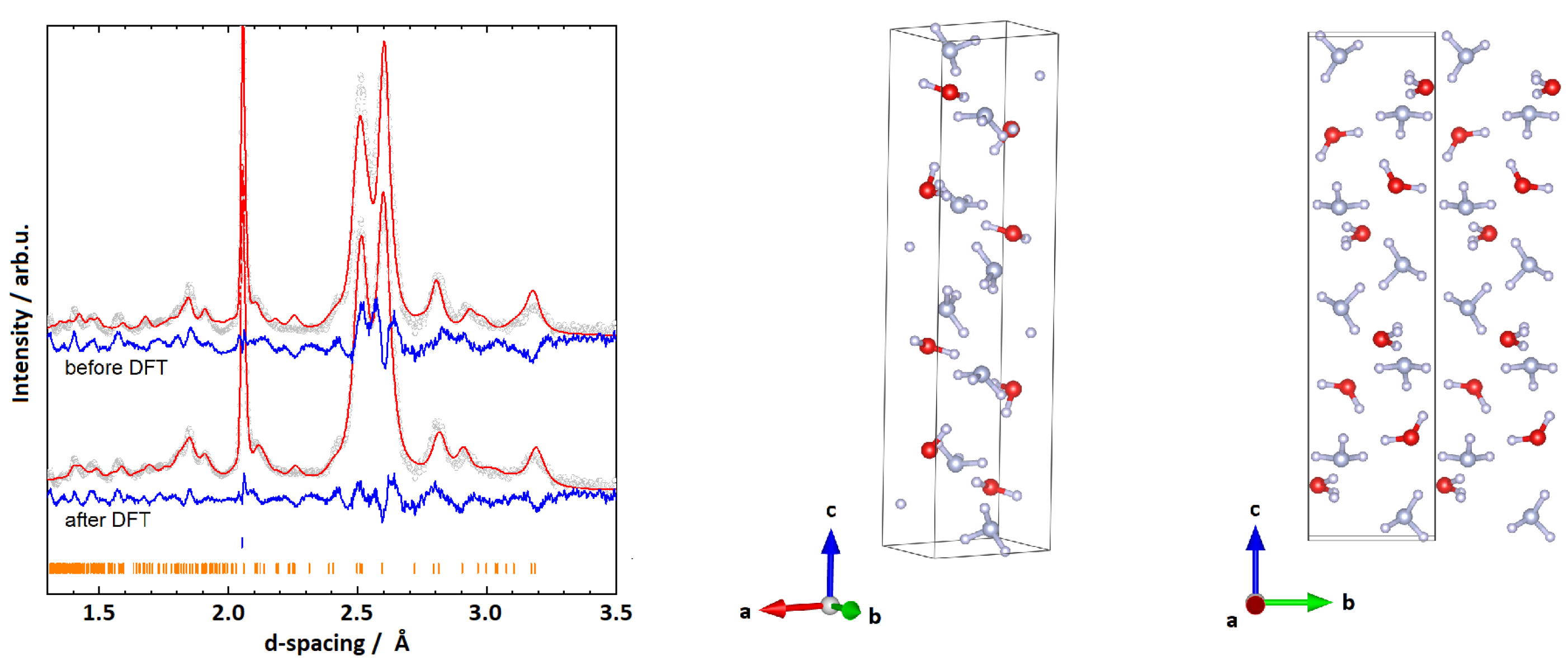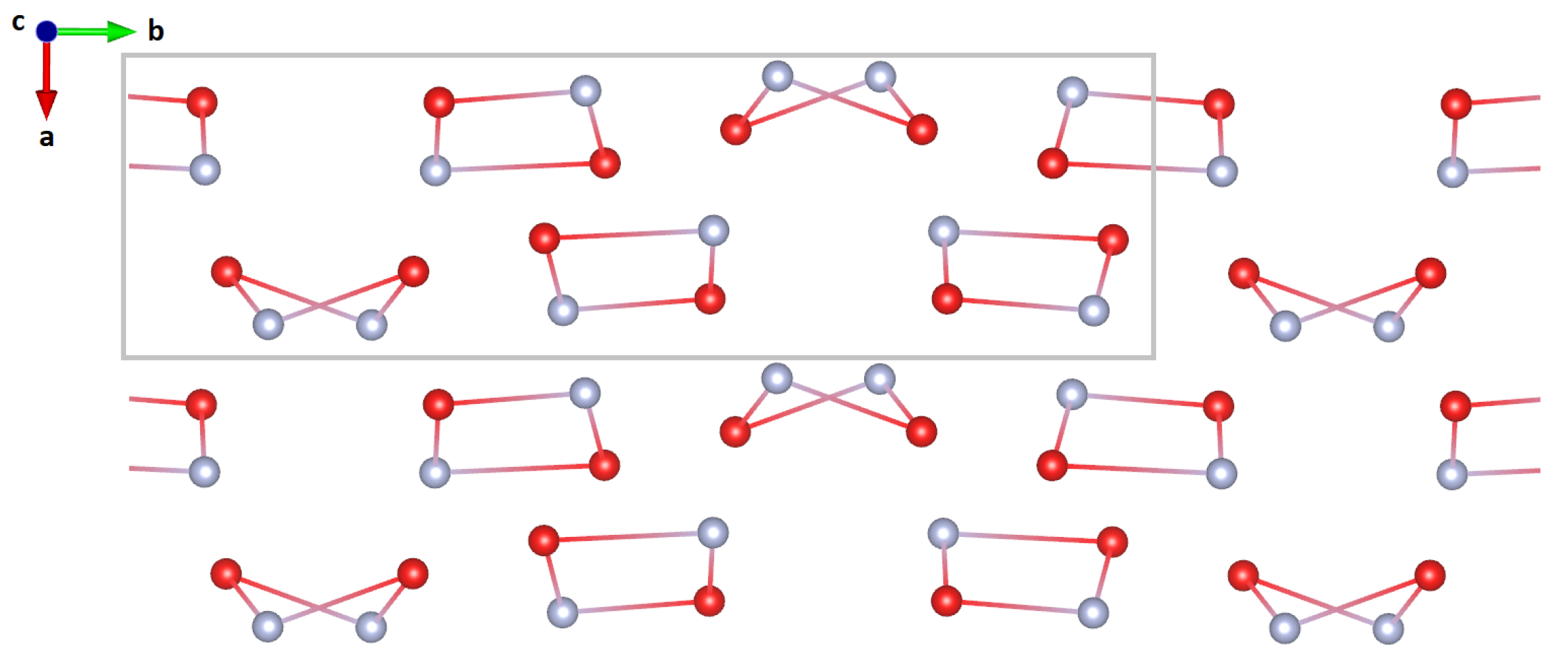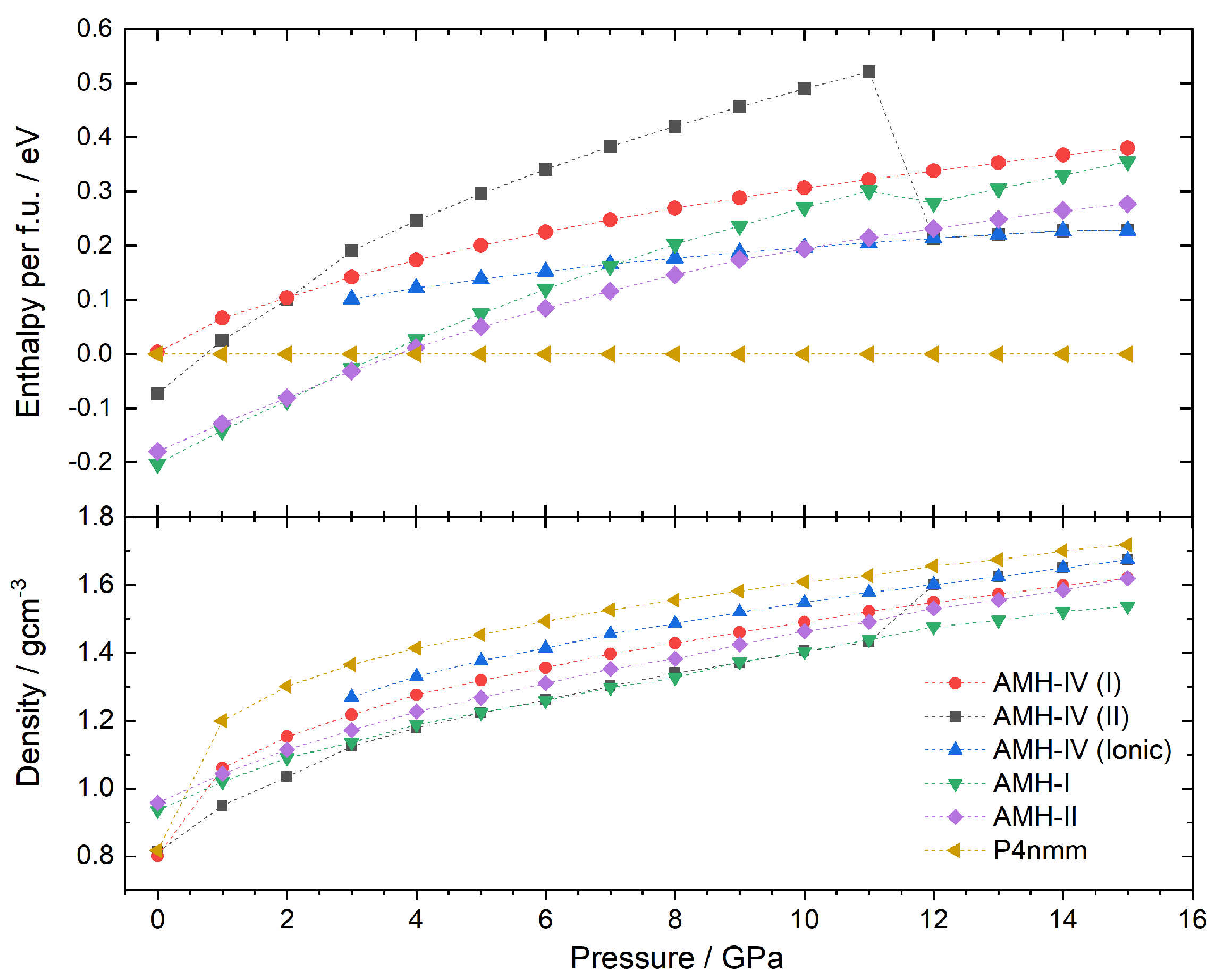Ammonia Mono Hydrate IV: An Attempted Structure Solution
Abstract
:1. Introduction

2. Materials and Methods
3. Results
3.1. Density of Ammonia Hydrate and Initial Indexing
3.2. Structure Search Using Monte Carlo Simulated Annealing
3.3. Two Structure Candidates Based on Rietveld Refinements
3.4. Structure and DFT Study of P (II)
4. Conclusions
Author Contributions
Funding
Institutional Review Board Statement
Informed Consent Statement
Data Availability Statement
Acknowledgments
Conflicts of Interest
References
- Berg, J.M.; Tymoczko, J.L.; Stryer, L. Biochemistry, 5th ed.; W. H. Freeman: Oxford, NY, USA, 2002. [Google Scholar]
- Loveday, J.S.; Nelmes, R.J. The ammonia hydrates-Model mixed-hydrogen-bonded systems. High Press. Res. 2004, 24, 45–55. [Google Scholar] [CrossRef]
- Lewis, J.S.; Prinn, R.G. Kinetic inhibition of CO and N2 reduction in the solar nebula. Astrophys. J. 1980, 238, 357. [Google Scholar] [CrossRef]
- Prinn, R.G.; Fegley, B. Kinetic inhibition of CO and N2 reduction in circumplanetary nebulae-Implications for satellite composition. Astrophys. J. 1981, 249, 308. [Google Scholar] [CrossRef]
- Lunine, J.I.; Stevenson, D.J. Clathrate and ammonia hydrates at high pressure: Application to the origin of methane on Titan. Icarus 1987, 70, 61–77. [Google Scholar] [CrossRef]
- Cynn, H.C.; Boone, S.; Stevensons, D.J. Proceedings of the 19th Lunar and Planetary Science Conference; Cambridge University Press/Lunar and Planetary Institute: Cambridge, UK, 1989; Volume 1, p. 433. [Google Scholar]
- Hubbard, H.B.; MacFarlane, J.J. Structure and evolution of Uranus and Neptune. J. Geophys. Res. Solid Earth 1980, 85, 225–234. [Google Scholar] [CrossRef]
- Young, L.A.; Stern, S.A.; Weaver, H.; Bagenal, F.; Binzel, R.P.; Buratti, B.; Cheng, A.F.; Cruikshank, D.; Gladstone, G.R.; Grundy, W.M.; et al. New Horizons: Anticipated Scientific Investigations at the Pluto System. Space Sci. Rev. 2008, 140, 93–127. [Google Scholar] [CrossRef] [Green Version]
- Sekine, Y.; Genda, H.; Sugita, S.; Kadono, T.; Matsui, T. Replacement and late formation of atmospheric N2 on undifferentiated Titan by impacts. Nat. Geosci. 2011, 4, 359–362. [Google Scholar] [CrossRef] [Green Version]
- Noack, L.; Snellen, I.; Rauer, H. Water in Extrasolar Planets and Implications for Habitability. Space Sci. Rev. 2017, 212, 877–898. [Google Scholar] [CrossRef]
- Mousis, O.; Gautier, D.; Coustenis, A. The D/H ratio in methane in Titan: Origin and history. Icarus 2002, 159, 156–165. [Google Scholar] [CrossRef]
- Koumvakalis, A. High Pressure Study of Ammonia Monohydrate. Ph.D. Thesis, University of California, Los Angeles, CA, USA, 1988. [Google Scholar]
- Loveday, J.S.; Nelmes, R.J. Ammonia monohydrate VI: A hydrogen-bonded molecular alloy. Phys. Rev. Lett. 1999, 83, 4329–4332. [Google Scholar] [CrossRef]
- Nelmes, R.J.; Loveday, J.S. ISIS Experimental Report RB9859; CCLRC Rutherford Appleton Laboratory: Chilton, WI, USA, 1998. [Google Scholar]
- Fortes, A.D.; Suard, E.; Lemee-Cailleau, M.H.; Pickard, C.J.; Needs, R. Crystal Structure of Ammonia Monohydrate Phase II. JACS 2009, 131, 13508–13515. [Google Scholar] [CrossRef] [PubMed]
- Loveday, J.S.; Nelmes, R.J.; Guthrie, M.; Belmonte, S.A.; Allan, D.R.; Klug, D.D.; Tse, J.S.; Handa, Y.P. Stable methane hydrate above 2 GPa and the source of Titan’s atmospheric methane. Nature 2001, 410, 661–663. [Google Scholar] [CrossRef] [PubMed]
- Fortes, A.D.; Wood, I.G.; Alfredsson, M.; Vocadlo, L.; Knight, K.S.; Marshall, W.G.; Tucker, M.G.; Fernandez-Alonso, F. The high-pressure phase diagram of ammonia dihydrate. High Press. Res. 2007, 27, 201–212. [Google Scholar] [CrossRef]
- Wilson, C.W.; Bull, C.L.; Stinton, G.W.; Amos, D.M.; Donnelly, M.E.; Loveday, J.S. On the stability of the disordered molecular alloy phase of ammonia hemihydrate. J. Chem. Phys. 2015, 142, 094707. [Google Scholar] [CrossRef] [Green Version]
- Griffiths, G.I.G.; Fortes, A.D.; Pickard, C.J.; Needs, R.J. Crystal structure of ammonia dihydrate II. J. Chem. Phys. 2012, 136, 174512. [Google Scholar] [CrossRef]
- Dunaeva, A.N.; Antsyshkin, D.V.; Kuskov, O.L. Phase diagram of H2O: Thermodynamic functions of the phase transitions of high-pressure ices. Sol. Syst. Res. 2010, 44, 202–222. [Google Scholar] [CrossRef]
- Besson, J.M.; Nelmes, R.J.; Hamel, G.; Loveday, J.S.; Weill, G.; Hulld, S. Neutron powder diffraction above 10 GPa. Phys. B Condens. Matter 1992, 180, 907–910. [Google Scholar] [CrossRef]
- Bull, C.L.; Funnell, N.P.; Tucker, M.G.; Hull, S.; Francis, D.J.; Marshall, W.G. PEARL: The high pressure neutron powder diffractometer at ISIS. High Press. Res. 2016, 36, 493–511. [Google Scholar] [CrossRef] [Green Version]
- Toby, B.H.; Dreele, R.B.V. GSAS-II: The genesis of a modern open-source all purpose crystallography software package. J. Appl. Crystallogr. 2013, 46, 544–549. [Google Scholar] [CrossRef]
- Clark, S.J.; Segall, M.D.; Pickard, C.J.; Hasnip, P.J.; Probert, M.I.J.; Refson, K.; Payne, M.C. First principles methods using CASTEP. Z. Fuer Krist. 2005, 220, 567–570. [Google Scholar] [CrossRef] [Green Version]
- Perdew, J.P.; Burke, K.; Ernzerhof, M. Generalized gradient approximation made simple. Phys. Rev. Lett. 1996, 77, 3865–3868. [Google Scholar] [CrossRef] [Green Version]
- Monkhorst, H.J.; Pack, J.D. Special points for Brillouin-zone integrations. Phys. Rev. B 1976, 13, 5188–5192. [Google Scholar] [CrossRef]
- Wilson, C.W.; Bull, C.L.; Stinton, G.; Loveday, J.S. Pressure-induced dehydration and the structure of ammonia hemihydrate-II. J. Chem. Phys. 2012, 136, 094506. [Google Scholar] [CrossRef]
- Lebail, A. Whole Powder Pattern Decomposition Methods and Applications: A Retrospection. Powder Diffr. 2005, 20, 316. [Google Scholar] [CrossRef] [Green Version]
- Khachaturyan, A.; Semenovskaya, S. Statistical-Thermodynamic Approach to Determination of Structure Amplitude Phases. Sov. Phys. Crystallogr. 1979, 24, 519–524. [Google Scholar]
- Khachaturyan, A.; Semenovskaya, S. The Thermodynamic Approach to the Structure Analysis of Crystals. Acta Crystallogr. 1981, A37, 742–754. [Google Scholar] [CrossRef]
- Metropolis, N.; Rosenbluth, A.; Rosenbluth, M.; Teller, A.; Teller, E. Equation of State Calculations by Fast Computing Machines. J. Chem. Phys. 1953, 21, 1087–1092. [Google Scholar] [CrossRef] [Green Version]
- Fortes, A.D.; Wood, I.G.; Vocadlo, L.; Knight, K.S.; Marshall, W.G.; Tucker, M.G.; Fernandez-Alonso, F. Phase behaviour and thermoelastic properties of perdeuterated ammonia hydrate and ice polymorphs from 0 to 2 GPa. J. Appl. Crystallogr. 2009, 42, 846–866. [Google Scholar] [CrossRef]
- Payne, M.C.; Teter, M.P.; Allan, D.C.; Arias, T.; Joannopoulos, J.D. Iterative minimization techniques for ab initio total-energy calculations-molecular-dynamics and conjugate gradients. Rev. Mod. Phys. 1992, 64, 1045–1097. [Google Scholar] [CrossRef] [Green Version]
- Griffiths, G.I.G.; Misquitta, A.J.; Fortes, A.D.; Pickard, C.J.; Needs, R. High pressure ionic and molecular crystals of ammonia monohydrate within density functional theory. J. Chem. Phys. 2012, 137, 064506. [Google Scholar] [CrossRef] [PubMed] [Green Version]
- Robinson, V.; Wang, Y.; Ma, Y.; Hermann, A. Stabilization of ammonia-rich hydrate inside icy planets. Proc. Natl. Acad. Sci. USA 2017, 114, 9003–9008. [Google Scholar] [CrossRef] [PubMed] [Green Version]





| Atom | Site | x | y | z | U |
|---|---|---|---|---|---|
| D1 | 4e | 0.062(9) | 0.433(4) | 0.724(9) | 0.165(15) |
| D2 | 4e | −0.105(9) | 0.394(4) | 0.522(9) | 0.165(15) |
| D3 | 4e | 0.545(6) | 0.5092(18) | 0.266(5) | 0.006(5) |
| D4 | 4e | 0.388(6) | 0.5531(18) | 0.069(5) | 0.006(5) |
| D5 | 4e | 0.372(5) | 0.2823(12) | 0.558(3) | 0.177(16) |
| D6 | 4e | 0.343(5) | 0.2607(12) | 0.285(3) | 0.177(16) |
| D7 | 4e | 0.288(5) | 0.3429(12) | 0.359(3) | 0.177(16) |
| D8 | 4e | 0.986(5) | 0.2022(12) | 0.838(3) | 0.066(8) |
| D9 | 4e | 0.755(5) | 0.2596(12) | 0.776(3) | 0.066(8) |
| D10 | 4e | 0.733(5) | 0.1949(12) | 0.960(3) | 0.066(8) |
| D11 | 4e | 0.644(5) | 0.370(2) | 1.032(7) | 0.021(7) |
| D12 | 4e | 0.747(5) | 0.294(2) | 1.105(7) | 0.021(7) |
| D13 | 4e | −0.032(4) | 0.9612(7) | 0.112(4) | 0.026(6) |
| D14 | 4e | 0.212(4) | 0.9968(7) | 0.275(4) | 0.026(6) |
| D15 | 4e | −0.053(4) | 0.9870(7) | 0.375(4) | 0.026(6) |
| N1 | 4e | 0.274(5) | 0.2912(12) | 0.401(3) | 0.177(16) |
| N2 | 4e | 0.798(5) | 0.2084(12) | 0.815(3) | 0.066(8) |
| N3 | 4e | 0.024(4) | 0.9980(7) | 0.234(4) | 0.026(6) |
| O1 | 4e | 0.048(9) | 0.419(4) | 0.566(9) | 0.165(15) |
| O2 | 4e | 0.440(6) | 0.5501(18) | 0.231(5) | 0.006(5) |
| O3 | 4e | 0.599(5) | 0.321(2) | 1.054(7) | 0.021(7) |
Publisher’s Note: MDPI stays neutral with regard to jurisdictional claims in published maps and institutional affiliations. |
© 2022 by the authors. Licensee MDPI, Basel, Switzerland. This article is an open access article distributed under the terms and conditions of the Creative Commons Attribution (CC BY) license (https://creativecommons.org/licenses/by/4.0/).
Share and Cite
Massani, B.; Pruteanu, C.G.; Conway, L.J.; Robinson, V.N.; Hermann, A.; Loveday, J.S. Ammonia Mono Hydrate IV: An Attempted Structure Solution. Crystals 2022, 12, 135. https://doi.org/10.3390/cryst12020135
Massani B, Pruteanu CG, Conway LJ, Robinson VN, Hermann A, Loveday JS. Ammonia Mono Hydrate IV: An Attempted Structure Solution. Crystals. 2022; 12(2):135. https://doi.org/10.3390/cryst12020135
Chicago/Turabian StyleMassani, Bernhard, Ciprian G. Pruteanu, Lewis J. Conway, Victor N. Robinson, Andreas Hermann, and John S. Loveday. 2022. "Ammonia Mono Hydrate IV: An Attempted Structure Solution" Crystals 12, no. 2: 135. https://doi.org/10.3390/cryst12020135
APA StyleMassani, B., Pruteanu, C. G., Conway, L. J., Robinson, V. N., Hermann, A., & Loveday, J. S. (2022). Ammonia Mono Hydrate IV: An Attempted Structure Solution. Crystals, 12(2), 135. https://doi.org/10.3390/cryst12020135







